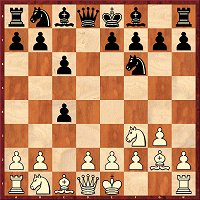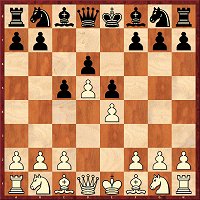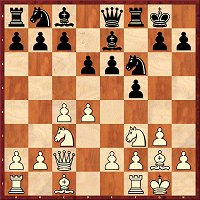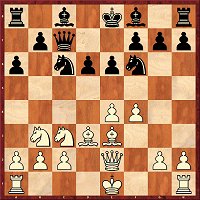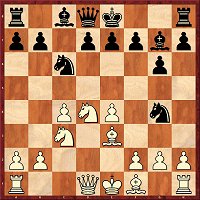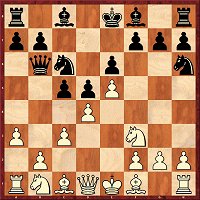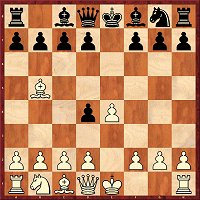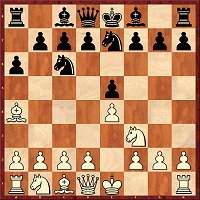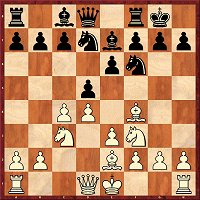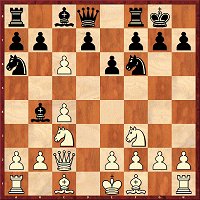
| Introductory videos
In his introductory video Karsten Müller takes a look at the recent top tournaments from November and December and passes comment on a few selected highlights, like the decisive moments in the game Movsesian-Meier, which clinched the gold medal for the German team in the European Championship and Kramnik's impressive win against Short in the London Chess Classic. Of the eleven openings articles on the DVD Müller mentions two in which ideas for your repertoire against the Ruy Lopez are presented. On one hand Marin's contribution on "Bird's Defence" (3...Nd4), and on the other Kuzmin's recommendation of 3...a6 4.Ba4 Nge7. |
 | Dorian Rogozenco begins his video review of tournament life with a selection of interesting game fragments from the European Championship, including a great innovation in the Queen's Gambit Accepted by GM Sulskis. From the Tal Memorial Rogozenco has chosen to demonstrate the decisive moment in the game Aronian-Svidler as an example of the creative playing style of the Armenian. In conclusion, the Romanian grandmaster presents Anish Giri's stroke of genius in Reggio Emilia in his pawn ending against Ivanchuk. |
| 27.12.2011-06.01.2012 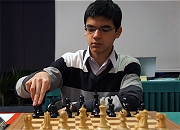
Anish Giri
| Reggio Emilia 2011/12 Chess tournaments cannot be any more exciting than this one. In a world-class field with an Elo average clearly above 2700, one round before the end three players were heading the table with the same number of points. In, as it were, a proxy battle the decision fell in favour of Anish Giri, the only one of the three not to lose his final round game! Morozevich gave away his game against Vitiugov shortly before the time control and Nakamura, who could have finished as the very clear winner in Reggio Emilia, lost three games in succession at the end of the tournament. You will find on the DVD all the games from this long-running tournament as well as a tournament report. |

Nakamura,H - Giri,A
Position after 21.Qd3
| Unlike Morozevich and Nakamura, who started the tournament at a furious pace, Anish Giri was unable to win a single one of his first four games. In view of the three-point rule, which has now been introduced in Reggio Emilia too, this was as you can imagine an unfavourable start. But then with three victories in four games he played himself back into the reckoning within touching distance of the leaders. Giri's victory as Black in the penultimate round against the until then leading player Nakamura turned out to be indicative of what would happen. In the game the American went energetically for Giri's Petroff Defence. But in 11...d5 the Dutch player quite deliberately had an innovation in mind which brought him a more flexible position than that after the 11...Qa5 played by Kramnik for example. So he managed to quickly neutralise White's apparent attack and himself to build up threats against the white king. In the analysis on the DVD Giri explains how in the position on the board he could have obtained for himself a clear advantage after 21.Qd3 with 21...Nxc3. Therefore he had to be patient until into the endgame which he decided in his favour with an exchange sacrifice. Click on the link under the diagram and let Giri explain the game to you move by move. |
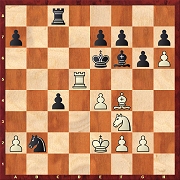
Morozevich,A - Caruana,F
Position after 24...c4
| The tournament went in principle along quite similar lines to Giri for Fabiano Caruana. After a very bad start (only one draw from three games) he too was still in a position to play for tournament victory in the final round and at the end he occupied a shared second place. On the DVD the Italian annotates his win over Morozevich from the sixth round. Morozevich attacked Caruana's Grünfeld Defence with 4.Bg5 and 5.h4 and despite strongly reduced material managed to exert strong pressure, because he was able to trap the black king in front of its own pawn chain. In the unusual position in the diagram on the left the black king has run out of breathing space, but White is unable to exploit this circumstance. After Caruana's 24...c4 Morozevich could have forced perpetual check with 25.Be5 (threatening: Nd4#!) 25...Bxe5 26.Ng5+ Kf6 27.Nh7+ Ke6 28.Ng5+. But he wanted more than that and after 25.Ra5 he soon lost the thread and at the end the game itself on account of the advanced c-pawn. |
| | |
| 03.12.-12.12.2011 
Vladimir Kramnik
4:0 against England
| London Chess Classic 2011 For the first time, the third London Chess Classic was not won by number one in the world rating list Magnus Carlsen. To do so the Norwegian would have had to defeat Anand in the last round but one... with Black, but that was not on the cards. Instead, in the same round, Vladimir Kramnik pulled away decisively with a victory over McShane. For this issue the tournament victor has commented in classical form on his victory with Black over Nigel Short. In addition, this DVD with its approx. 10 hours of audio analysis by the players (all recorded directly after their games) offers you a presentation in which you will not only learn heaps about chess but which will allow you to form an impression about the personalities of these top players. We offer you a selection of these analyses in the following sections. You will find the list of all the audio analyses on the DVD on the page devoted to the London Chess Classic. |

Short,N - Kramnik,V
Position after 12...Qf5
| The key to Kramnik's tournament victory lay in his wins against the four English players in the field (he drew all his remaining games). His first sacrifice was, in round 2, Nigel Short, who on the occasion of the first London Chess Classic in 2009 had brought him to the very brink of defeat. This year it never looked like that at any point. The position levelled out completely after the opening and in the position on the board after 12...Qe6-f5 the exchange of queens with 13.Qxf5 would certainly have led to a rapid draw. But the English player obviously preferred something a bit more subtle and played instead 13.Be7. In doing so he missed the subtle point 13...Qxf3 14.gxf3 a6! Suddenly the position once more requires concrete calculation and most of the variations are in Black's favour. Vladimir Kramnik explains to you in his analysis the mistakes which Short was led to make in the subsequent play and also the quite simple looking wrinkles with which he decided the game in his favour. |

Kramnik - Howell
Position after 19...Bc6
| After Adams in round five the young English player David Howell was Kramnik's next sacrificial lamb. In the audio analysis audio analysis of this game which was already so interesting in the opening the ex world champion shows some breathtakingly deeply calculated variations which clearly astound both the spectators and even his co-commentators. Had Kramnik not expressed the view just the previous day that he was "too old" for calculating? In the approx. 16 minutes of analysis Kramnik presents a multitude of instructive opinions and ideas, and shows how, step by step, he turned his initiative into a decisive advantage. The diagram shows perhaps the key position in the game. Here Kramnik continued 20.Bg5 Bxg5 21.Rxc5. |

Carlsen and Nakamura
comment on
Carlsen - Nakamura
| Magnus Carlsen and Hikaru Nakamura both started the tournament with a victory and a draw. So their third round duel would clearly be of a trend-setting nature. But at first there was nothing very spectacular about the game. Carlsen opened with the Italian Game, got in his own words a position which was simply easier to play for White but no objective advantage. But Nakamura was out for a win too and turned down a chance to simplify after 29...Ng4. A mistake which allowed Carlsen an obvious exchange sacrifice on f6. After the careless 34...Ra8? the Norwegian won with a resounding attack on the king. |

Carlsen - Kramnik
Position after 12...Qa6
| The games between Kramnik and Carlsen are always interesting (see also the game Kramnik-Carlsen in the Tal Memorial, also on the DVD). The two top players discuss their encounter together with Daniel King in their post-mortem analysis on the DVD. Above the future tournament winner is critical about how the opening went and explains the basic dilemma he found himself faced with in the position on the board after Carlsen's 13.Qd3. After the exchange on d3 and the subsequent knight exchange on c6 the position is more unpleasant for Black than it may appear at first glance. He must try to exchange a pair of rooks and to prevent a pawn storm by White - but doing both at the same time does not work properly. Click on the link under the diagram and enjoy this top class game with the instructive commentary from both stars! |
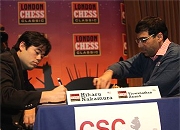
Hikaru Nakamura
annotates
Anand - Nakamura
| Vishy Anand was quite involuntarily responsible for another tournament highlight in the fourth round. In the sharp 9.b4 variation of the Classical King's Indian Hikaru Nakamura gave himself the luxury of an extra tempo against the world champion (h7-h6-h5) and a few moves later was contemplating the ruins of his position. But then Anand obviously took matters too lightly. From a much superior position the tables were completely turned around move 25. All of a sudden the black pieces came to life and there was soon no longer any defence against Nakamura's storm on the kingside. The London tournament, like the Tal Memorial before it, was disappointing for the world champion. With only one win, against Nigel Short, he reached only 50%, the same as in Moscow. Nakamura describes his impressions of this game in the audio analysis. |
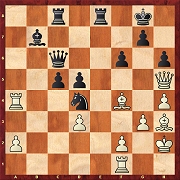
Nakamura - Howell
Position after 26...Qc6
| Apart from McShane, who even managed to get among the front runners and went on to occupy a very honourable fourth place, the English players generally had a bad time of it, as was expected. One example of this is Howell's defeat at the hands of Nakamura in round 5. The American came out of an English Opening with 3.g3 with a slight initiative, but Howell defended cautiously for a long time. In an objectively level position but one with a lot of possibilities, the English player - according to the judgement of both players in their audio analysis - committed the decisive error with 26...Qc6 (diagram). Nakamura may not have chosen the best continuation after 27.Rb1 Ra8 28.Rxa8 with 29.Bg2 (29.Re1 Kf8 30.Bxh6 wins immediately), but it was sufficient to move the game on into a clearly won endgame. |

Carlsen comments
Carlsen - Adams
| This year things went even worse for Michael Adams than for Howell. His three draws and five defeats left him in last place at the end. Of course he too could have done better. Just like Howell in the game above, Adams reached, e.g. against Carlsen, a decent position with Black, but somehow he missed an important detail (35...Nc4? - 36.Rxd5 and it's all over). In his normal laconic audio analysis Carlsen, who was not particularly happy with this game, amazes his co-commentator Daniel King from time to time with surprisingly positive evaluations of his position: "Now I was fairly happy, I thought that White might be slightly better here." "Really?" "Yeah." "Really? Even with the queen on e1?"... |
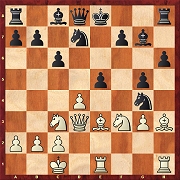
Short - McShane
Position after 13.Bh3
| Another "eye-catcher" in London was the battle between Short and McShane in the King's Gambit, also when we consider the extremely fascinating audio analysis with Nigel Short just after the game. In it you will learn, e.g., under which conditions you can play this "lousy opening" and why the King's Gambit is okay anyway. In the game itself Short was only able to provoke some turmoil at the very start. McShane always maintained an overall view of what was happening and in the position on the board brought his king to safety with 13...Nxe3 14.Rxe3 0-0 15.Ne4 Nf6 and in so doing set himself on the route to victory. At the end the game was decided by his four linked passed pawns on the kingside. |
| | |
16.11.-25.11.2011 
Magnus Carlsen
Another cup!
| Moscow Tal Memorial 2011 The Tal Memorial in Moscow must have secured a firm place in the history of chess tournaments. With Anand, Carlsen, Aronian and Kramnik there were four players with over 2800 Elo in the starting blocks, and then there were the WCh challenger Gelfand and three talented young players in the form of Karjakin, Nakamura and Nepomniachtchi - all possible future candidates for the WCh throne. An unusual rule accorded victory in the tournament to Magnus Carlsen, who had 5.5 out of 9 just like Aronian but who was declared winner because he had the larger number of game with Black. In any case in Moscow the Armenian gained some more Elo points and in the FIDE ranking list (as of January 2012) occupies second place, ahead of Kramnik and Anand. |
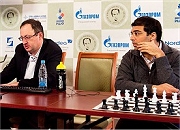
Gelfand and Anand
Soon to be back in Moscow
| The encounter between world champion and challenger in Moscow took place without any great sabre rattling. In the final round Anand and Gelfand soon parted with a draw. For both of them the tournament as a whole had been something of a disappointment. Neither managed to win a game, and Gelfand had to submit to defeats at the hands of Carlsen and Karjakin. On the DVD you will find these two losses of Gelfand, in each case with annotations by the winner. |
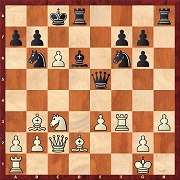
Carlsen,M - Gelfand,B
Position before 18...Ng4
| At the finish of his analysis Magnus Carlsen describes his win over Gelfand as "one of my most exciting games of late". And in fact it is a game played in top class fashion by both sides and also an extremely complex one. Carlsen first of all required his opponent to castle queenside with his subtle 13.Qc2. But then Gelfand took over at first and won the exchange after 18...Ng4 19.cxb7+ Kb8 20.gxh4 Rh1+ 21.Kf2 Rxa1. In that position many another player would perhaps have become nervous with White. But not Carlsen, who seemed "fascinated and quite excited by the unusual character of the position". Gelfand later became painfully aware of how well the young Norwegian understands how to play such positions (24.g5!). Click on the link under the diagram and enjoy the analysis of the number one in the world ranking list! |

Gelfand,B - Karjakin,S
Position before 32.Rc7
| As expected, in round three Gelfand and Karjakin set off on an excursion into the theory of the Catalan. In a position which Karjakin had already had against Ivanchuk, Eljanov and Caruana, the Israeli introduced the innovation 16.Rd3 with the idea of placing the rook in front of his own pawns on the kingside. As Sergey Karjakin makes clear in his analysis, this manoeuvre does not set Black any serious problems. More than that, caution was required. In the position in the diagram on the left Gelfand played the natural looking attacking move 32.Rc7 and was promptly at a disadvantage. Because Karjakin riposted with 32...Rbd8. The key: 33.Rbxg7 fails to 33...Rg8 winning a piece. In the game Gelfand bit the bullet with 33.e4, but after 33...Bf8 34 Qc3 b4 Black was already clearly better. |
03.11.-11.11.2011 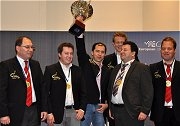
The German team
We are the champions!
| European Team Championship 2011 The greatest success in German chess for more than 70 years happened on a memorable date: On the 11.11.11 the team of Arkadij Naiditsch, Georg Meier, Jan Gustafsson, Daniel Fridman and Rainer Buhmann sealed the win of the 2011 European Team Championship with a 2.5:1.5 victory over the reigning world team champions from Armenia. A glance at the countries which the German team was able to defeat on its way to the title makes it clear that their success cannot be characterised as anything other than well deserved: in Hungary, the Ukraine, Azerbaijan and Armenia they swept aside four major chess powers. The only one top favourite "missing" from the list of Germany's opponents was Russia. Once more that team built around Grischuk and Svidler fell out of the running at an early point and once again were out of the medals in 5th place.
|

Georg Meier
Match winner against Armenia
| A characteristic of the German success story was the unified team performance. No player performed worse than the others and each could consider himself a match winner on at least one occasion. In the final round in which everything was decided, Rustam Kasimdzhanov, who did excellent work for the German team as their openings trainer at the ECh, handed this role to Georg Meier who would be meeting Movsesian with Black. The marching orders were that all the other three games should be draw. And that was exactly what came to pass! |
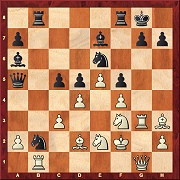
Movsesian,S - Meier,G
Position after 22...Ne6
| Georg Meier comments on this key game from the final round for you on the DVD and in doing so goes into the special circumstances. Naturally the German player again chose the French Defence but did not play his Rubinstein Variation, so that he could get into a "full-blooded" game. He was soon rewarded for doing so, because Movsesian was unable to find a good plan in the side variation he himself had chosen. After the mistake 15.Bh3 Meier locked up the centre immediately with 15...f5 and got excellent play on the queenside. A short time later - after 22...Ne6 (diagram) -Black was already clearly winning simply in view of his positional advantage. Click on the link under the diagram and enjoy the way the German grandmaster won and his analysis. Just as important as this win was Jan Gustafsson's draw with Black against Sargissian. The grandmaster from Hamburg had to fight to the bitter end in order to secure his draw and with it the gold medal. In his Endgame column Karsten Müller pays homage both to Gustafsson's endgame technique and to two other brilliant German performances in the ECh. |
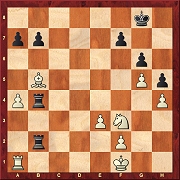
Mamedyarov,S - Fridman,D
Position after 30...Rgb4
| Another gold medal winner, Daniel Fridman, has commented on two of his games for this CBMagazine. In the penultimate round against the of course equally highly favoured team from Azerbaijan, he had to cross swords with Mamedyarov who is at present no. 14 in the world ranking list. There was a good omen: in their previous encounters in the 2009 ECh and the 2010 FIDE World Cup Fridman was able to draw all his games with Black. In the opening everything went according to plan, but in the critical position after 17.Qxd5 Fridman's continuation was too passive and two moves later he got into severe trouble on account of a faulty evaluation. In the position on the board on the left Mamedyarov could have played 31.Bd3 to prevent the exchange of a rook and to conserve his advantage. After the text move 31.Rd1, on the other hand, Black achieved equality with 31...Rb1. In his analysis Daniel Fridman describes his exciting and finally successful struggle for survival with rook versus knight+bishop. |

The latest theory
by Mihail Marin
| On the DVD you will find all 684 games from the European Championship. GM Mihail Marin has brought together for you the most interesting theoretical innovations and developments in an openings survey. Once again, the key themes are the Queen's Gambit in all its many lines, the Classical Nimzo-Indian with 4.Qc2, White's attempt to gain an advantage against the Grünfeld Defence with Bg5, the French and the Spanish (above all the Steinitz Variation). But Marin also indicates interesting games from Porto Caras in many other systems and often blends his own evaluations into his comments. |

Sutovsky,E - Adams,M
Position after 30...Qc6
| The prize for the best score on first board was won by Michael Adams with 6.5 out of 9 and an Elo-performance of 2841. Emil Sutovsky has analysed his game with White against the English player and rues his lost chances. The Israeli avoided "Mickey's" Marshall with the recently ever-more popular 6.d3 and set out according to his preparation to have a very positional game. If you simply play through the game you have the impression that not very much happened. But in his analysis Sutovsky points to a whole series of positional nuances. In fact - according to his own conclusion - in the position on the board he had in his hand the chance to decide the game. Instead of the text move 31.Re6, which led directly to the draw, 31.Nh4 Re8 32.Rxe8 Qxe8 33.b3! would have given him a "strategically won" position. |

Position after 5...Qb6
Why is the queen move wrong here?
See the Opening trap
| From the opening trap to the endgame study Training in ChessBase Magazine starts with the very first moves and takes in all the phases of a game of chess. The latest 11 opening articles with their numerous ideas and suggestions for your repertoire can be found above among the links. Rainer Knaak's opening trap (including its Fritztrainer video) contains on this occasion a trap in the Sicilian (B33), see diagram on the left. Also in video format there are the openings contributions by Leonid Kritz (French Winawer Variation), Valeri Lilov (London System) and Adrian Mikhalchishin (Nimzo-Indian). You will find these videos in the fritztrainer column. The subject of Peter Wells' strategy-column is: "Understanding prophylaxis". Daniel King's long running Move by Move contains a game featuring the Torre Attack. And in the columns devoted to tactics (subject: Sink or swim) and the endgame (subject: technique in rook endings) Oliver Reeh and Karsten Müller have once more brought together for you all that is best in recent tournament practice. |




























